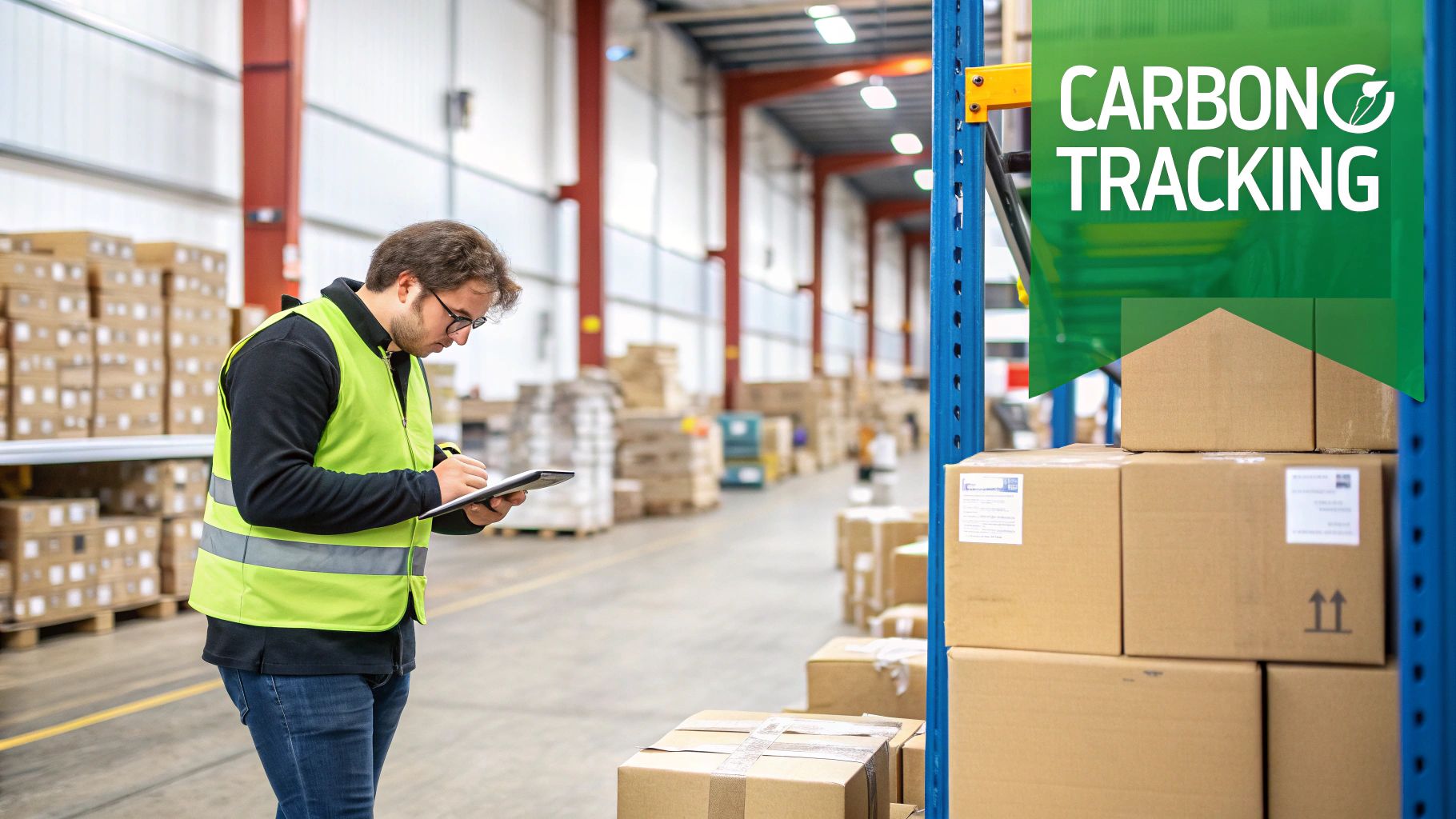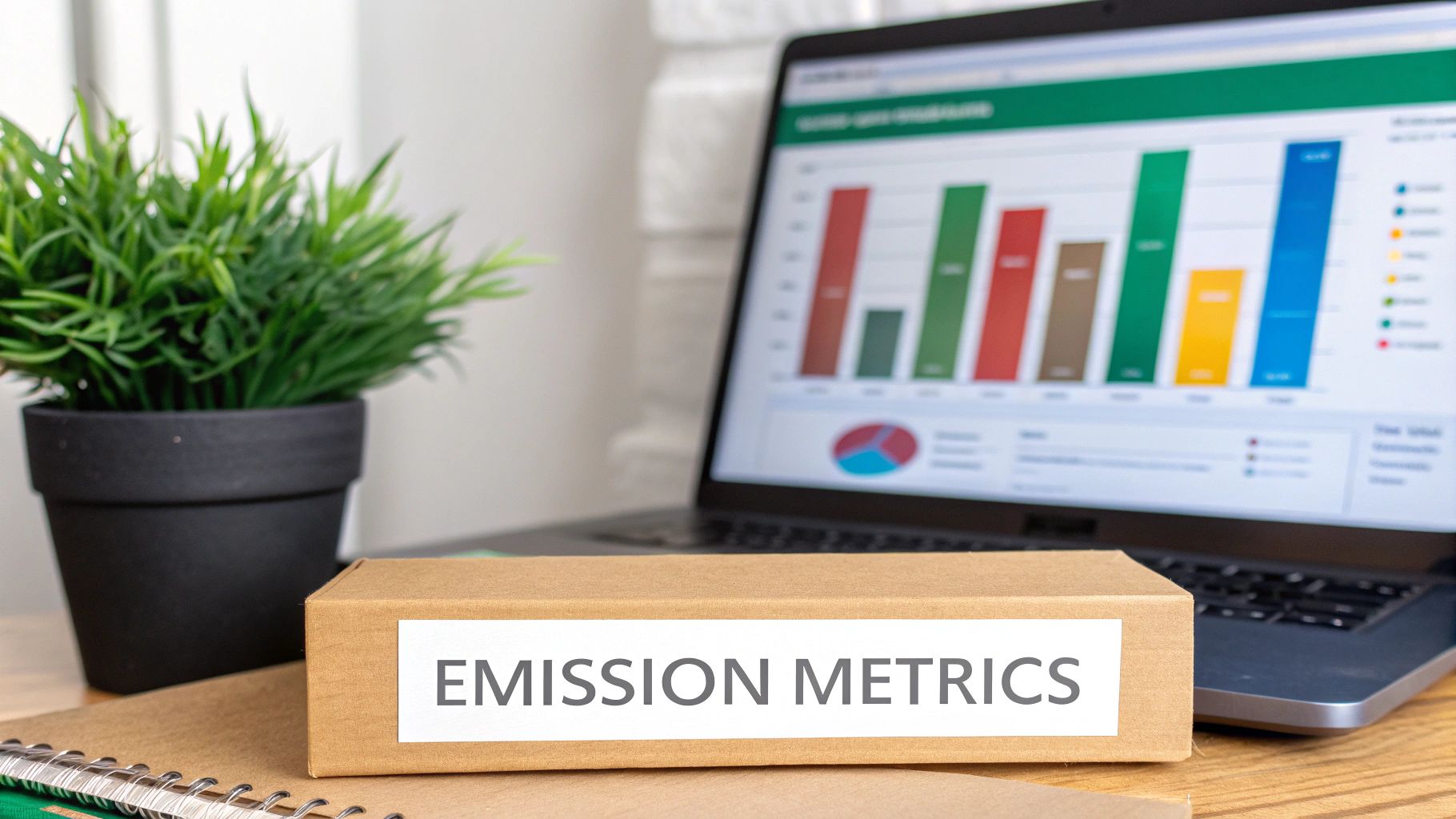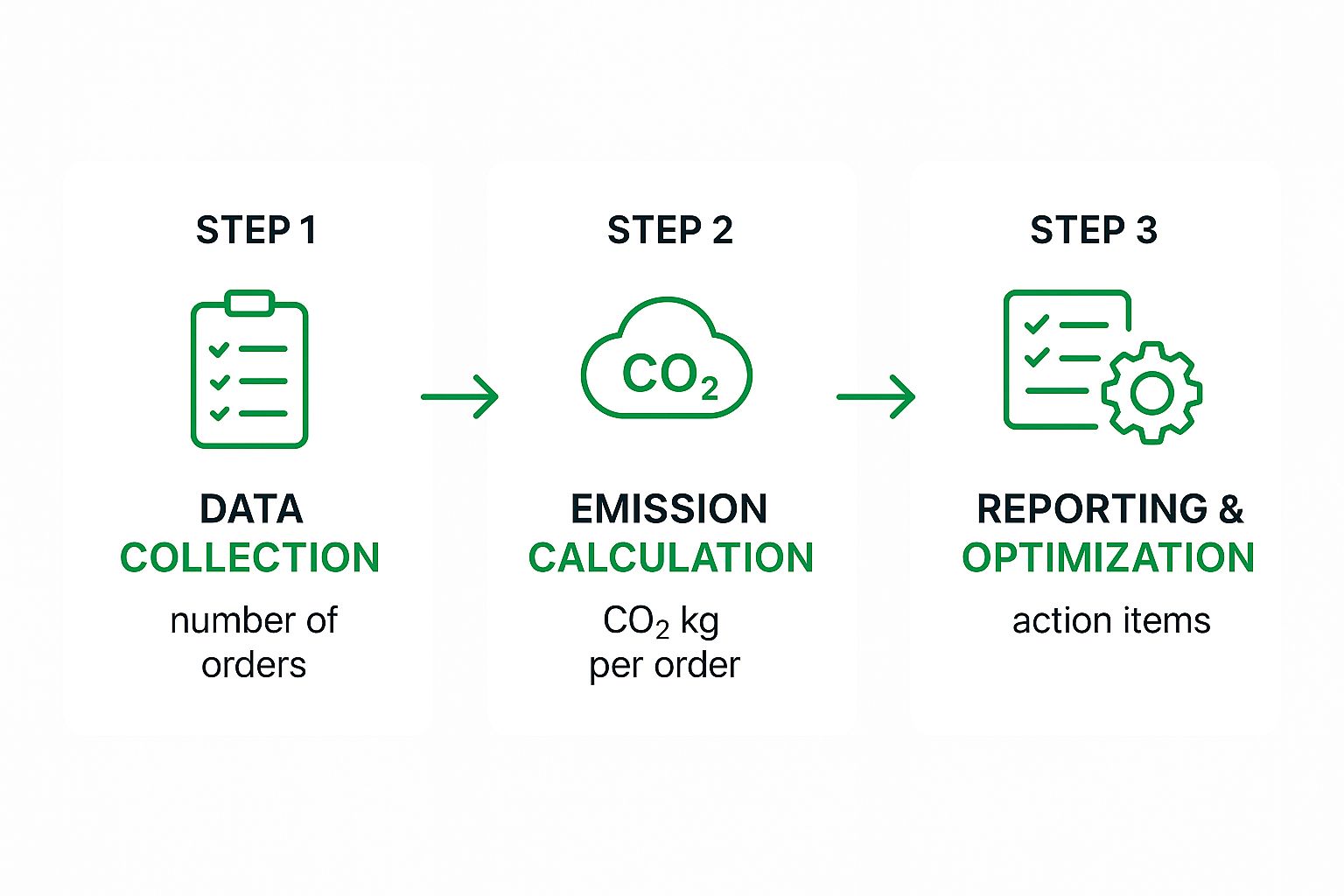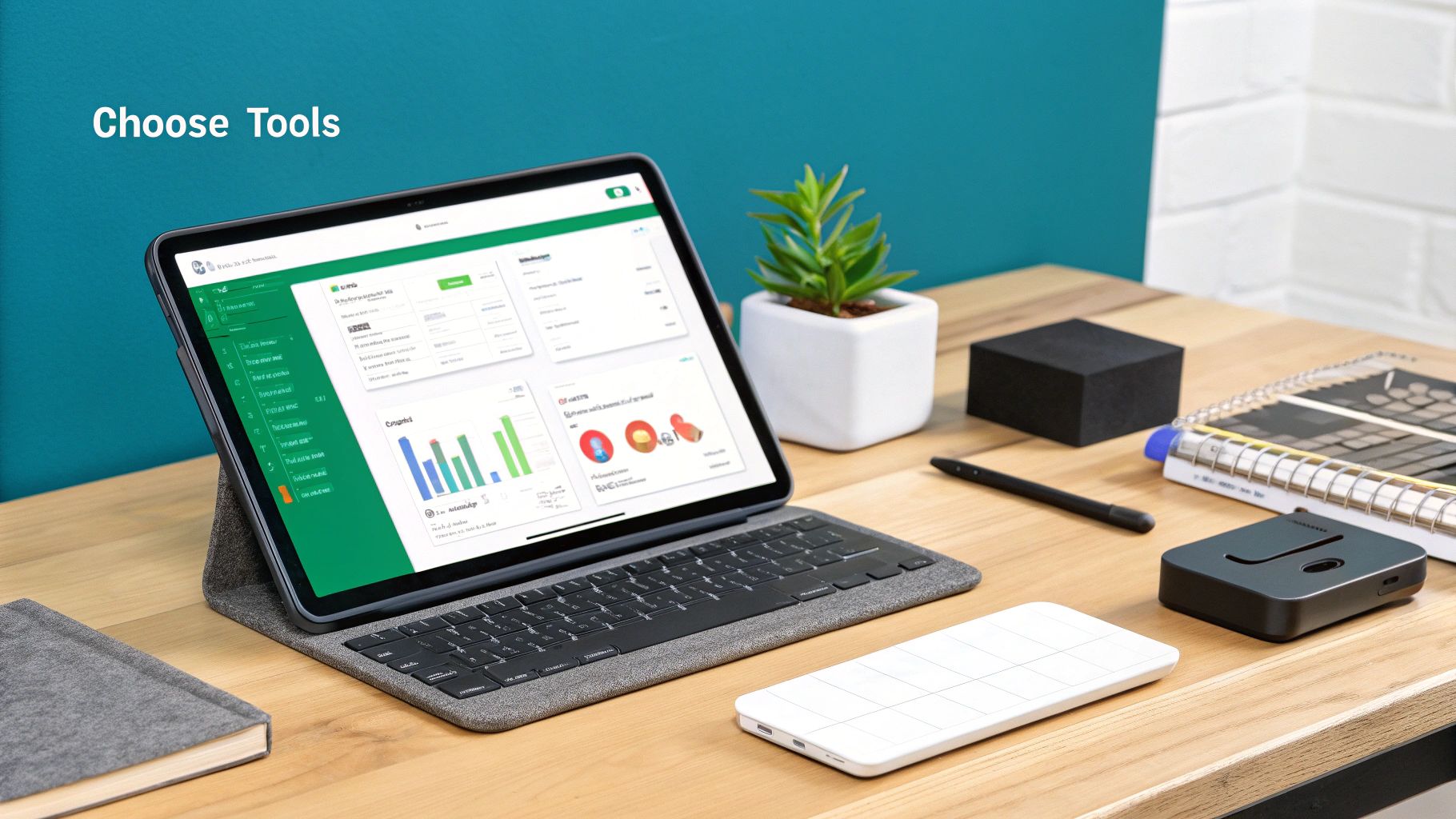Carbon Tracking for E-Commerce Businesses Explained
Karel Maly
July 13, 2025
When we talk about carbon tracking for an e-commerce business, what do we really mean? It’s the nitty-gritty process of measuring and analysing all the greenhouse gas emissions your online shop produces. This isn't just about your delivery vans; it covers the entire lifecycle, from product manufacturing and packaging right through to shipping and returns. The goal is to get a crystal-clear picture of your environmental impact, which is the first step towards actually reducing it.
Why E-Commerce Can't Ignore Carbon Tracking Anymore

Let's be honest, understanding your carbon footprint used to feel like a "nice-to-have." Not anymore. Today, it’s a core business function. The pressure is mounting from every angle, pushing sustainability from a marketing buzzword into a critical part of how we build resilient, growing businesses.
Modern customers are savvy. They don't just buy products; they buy into brands that reflect their own values. For a growing number of people, this means actively seeking out businesses that are open about their environmental impact and are making real, measurable changes. Being transparent here isn't just good ethics—it's a powerful competitive advantage.
Getting to Grips with Emission Scopes
To track your carbon footprint effectively, you first need to understand where the emissions are coming from. The standard framework for this is the Greenhouse Gas (GHG) Protocol, which organises emissions into three "scopes." Think of them as buckets for different types of pollution.
- Scope 1: These are your direct emissions. It's the stuff you burn yourself. For an e-commerce brand, this could be the fuel used in your own delivery vehicles or the natural gas heating your warehouse.
- Scope 2: This bucket is for indirect emissions from the energy you buy. The biggest culprit here is usually the electricity powering your warehouses, offices, and even the servers hosting your website.
- Scope 3: Here’s the big one. This covers all the other indirect emissions happening up and down your value chain. It’s a huge category that includes manufacturing your products, the impact of your third-party logistics partners (3PLs), producing your packaging, and even what happens when a customer returns an item.
For the vast majority of e-commerce brands, Scope 3 emissions are by far the largest part of their carbon footprint. This is where you'll find the toughest challenges, but it's also where you can make the most significant positive impact.
The Shifting Tides of Regulation and Market Demands
The push for accountability isn't just coming from your customers. Governments, particularly in the EU, are tightening the rules. We're seeing new regulations emerge that will soon require businesses of all sizes to report on their environmental performance. Getting a handle on your carbon tracking now is a smart, strategic move to get ahead of these compliance deadlines.
Here in the Czech Republic, for example, there's a real push to align economic growth with environmental responsibility. While the nation has achieved a remarkable 37.1% reduction in total GHG emissions, sectors tied to logistics and commerce are still major contributors. This puts direct pressure on online retailers to actively manage their footprint.
This changing environment means that ignoring your carbon output is no longer just an environmental blind spot—it's a genuine business risk. By getting proactive with your emissions measurement, you can uncover operational inefficiencies, cut costs, build stronger customer loyalty, and future-proof your business for a world where sustainability is simply the standard.
If you want to dig deeper into the supply chain side of things, our guide on carbon accounting for supply chains is a great place to start.
Finding Your E-commerce Carbon Hotspots

Before you can reduce your carbon footprint, you have to know where it's coming from. This means taking an honest look at your entire business to find the activities generating the most emissions. These are your carbon hotspots.
For any e-commerce brand, the hotspots tend to pop up in the same few areas. However, the size of each hotspot can be wildly different depending on what you sell and how you run things. It’s all about tracing the lifecycle of every single order.
The Hidden Emissions in Your Products
The carbon story of your products starts long before a customer ever adds them to their cart. In my experience, the manufacturing and sourcing of goods represent the single largest—and most frequently ignored—chunk of an e-commerce company's Scope 3 emissions.
Let’s look at two completely different online stores:
- A fast-fashion brand: Their supply chain is probably a tangled global web. The real carbon culprits here are the energy-hungry processes for making synthetic fabrics like polyester, the massive amount of water needed to grow cotton, chemical dyeing, and the international freight required to get those clothes into your fulfilment centre.
- An electronics shop: Their hotspots look different. Think about the emissions from mining rare earth metals for tiny components, the incredible amount of energy needed for microchip fabrication, and an assembly line that might stretch across several countries.
What this shows is that your product's origin story is its carbon story. To get a real handle on carbon tracking for your e-commerce business, the first step is always to map your supply chain and pinpoint those key production stages.
Every product arrives at your warehouse with a carbon cost already baked in. You have to get a grip on this "upstream" footprint because it often completely dwarfs the emissions from your own day-to-day operations.
Nailing Down Your Operational and Logistics Hotspots
Once those products are in your hands, your own operations start adding to the carbon count. The good news? This part is usually much easier to measure and control, which means you can score some quick wins here.
Warehouse Operations
Your fulfilment centre is a beehive of activity, and all that activity uses energy. You’ll want to scrutinise a few key areas:
- Electricity: This covers everything from lighting and heating to conveyor belts and charging stations for your equipment.
- Waste Management: Every bit of discarded cardboard, plastic film, and damaged inventory has a carbon price tag tied to its disposal and replacement.
Your Packaging Footprint
The boxes, mailers, and padding you choose have a direct and immediate impact. Someone shipping fragile glassware will naturally have a bigger packaging footprint than a brand selling t-shirts. Material and weight are everything. I’ve seen businesses make a huge dent in their per-order emissions just by switching from a heavy, virgin cardboard box to a lightweight, recycled mailer.
Shipping and the Final Mile
For your customers, this is the most obvious part of your carbon footprint. The emissions generated here are a direct result of:
- Distance: How far does the package travel from your warehouse to their front door?
- Transport Mode: Air freight is a notorious carbon hog, far worse than ground or sea shipping.
- Delivery Density: Dropping off packages in a dense urban area is far more efficient than driving out to a single rural address.
- Failed Deliveries: A single missed delivery can easily double the carbon cost of that final, crucial leg of the journey.
By breaking down your business into these distinct stages—from raw material to the customer's doorstep—you're no longer staring at a vague, overwhelming problem. Instead, you have a clear map of your carbon hotspots and a concrete list of data points to collect, measure, and improve upon.
Getting Your Hands Dirty: How to Collect and Measure Emissions Data
Right, let's move from the 'what' to the 'how'. This is where the real work begins, but don't worry—getting a handle on your emissions data is a lot less intimidating than it sounds. The secret to effective carbon tracking for e-commerce businesses isn't about capturing every single gram of CO₂ from day one. It’s about starting with the big, easy-to-grab pieces of the puzzle to build a solid foundation.
You can always refine and expand later. The initial goal is simply to establish a baseline you can trust.
This flow chart breaks down the entire process, from grabbing the raw numbers to using them to make smarter, greener decisions.

As you can see, it's a loop. Reporting your findings and making optimisations will naturally lead you back to collecting even better data next time. It's all about continuous improvement.
Start with Your Core Activity Data
The first step is to collect what the experts call activity data. Forget the complex jargon; this is just the raw information about what your business does day-to-day. Think of it like gathering ingredients before you can figure out the nutritional value of a recipe.
Here are the essential bits of information you’ll want to track down first:
- Warehouse Utilities: Pull out your monthly electricity and gas bills. This is the simplest way to get a handle on your Scope 2 emissions.
- Packaging Materials: You need to know the weight and type of packaging you’re buying. How many kilograms of corrugated cardboard did you use last quarter? What about recycled poly mailers or that crinkly void-fill paper?
- Shipping and Logistics: For most e-commerce shops, this is the big one. Your shipping carriers are your best source of information here. They can usually provide reports detailing the total weight of your shipments and the distances they travelled.
- Fuel Consumption: If you run your own delivery vans (a classic Scope 1 emission), you’ll need to track your fuel purchases. This is one of the most direct and accurate data points you can get.
A quick tip from experience: Don't let the pursuit of perfection stop you from starting. If your carrier can't give you the exact mileage for every single package, use averages based on shipping zones. A well-reasoned estimate is infinitely better than having no data at all.
Picking the Right Way to Calculate Your Emissions
Once you've got your activity data, you need to turn it into a carbon equivalent (CO₂e) figure. There are two main ways to do this, and the best one for you depends on how much time you have and what you want to achieve.
The Spend-Based Method
This is the fast-and-dirty approach to get a rough idea of your footprint. You simply take how much you spent on something (say, €5,000 on shipping) and multiply it by a standard, industry-average emissions factor for that service.
- The Good: It's quick and uses data you already have in your accounting software.
- The Bad: It's the least accurate method by a long shot. It won't tell you why your emissions are high, just that they are.
Think of this as a starting point for a high-level overview, but it’s not precise enough for making serious plans to cut your carbon.
The Activity-Based Method
This is the gold standard. When you’re ready to get serious, this is the method to use. Instead of using your spending, you use your specific activity data (like shipping 100 kg of air freight over 5,000 km) and multiply it by a much more precise emissions factor for that exact activity.
- The Good: It's incredibly accurate and gives you clear, actionable insights. You can directly see how switching to a lighter box or a different shipping mode impacts your total emissions.
- The Bad: It demands more effort. You'll need to work more closely with your suppliers and partners to gather that detailed data.
For any business truly committed to managing its environmental impact, the activity-based method is a must. The initial effort pays for itself with the quality of information you get back, forming the bedrock of any meaningful reduction strategy.
Reducing Your Packaging and Logistics Footprint

When you run an online store, your packaging and shipping are the real heavy hitters of your carbon footprint. This is where your environmental impact becomes tangible for your customers, and honestly, it’s where you can make some of the biggest and most immediate improvements.
Let’s talk materials. The boxes and mailers you use are a huge piece of the puzzle. In the Czech e-commerce scene, packaging is a major source of emissions, not just from the materials but from the energy needed to create them. Think about cardboard—it's everywhere, but producing it requires a shocking amount of resources. To make just one kilogram of paper packaging, it can take around 2,700 litres of water and pump out a significant amount of CO₂. For a deeper dive, check out the analysis of e-commerce packaging’s environmental effects at Packaging Gateway.
This data alone makes it crystal clear why smart packaging choices are at the heart of effective carbon tracking for e-commerce businesses.
Rethinking Your Packaging Strategy
Your first mission, should you choose to accept it, is to eliminate empty space. So many brands ship small items in huge boxes. "Right-sizing" your packaging to snugly fit the product isn't just about using less cardboard; it makes your shipments lighter and smaller. That often translates directly to lower shipping costs and a smaller carbon footprint for every single order.
Here are a few practical moves you can make:
- Go Lighter & Recycled: Could that rigid box be replaced with a lightweight, padded mailer made from recycled materials? Every gram you shave off adds up.
- Ditch Useless Fillers: Swap out those plastic air pillows for recyclable crinkle paper. Even better, can you design your packaging so it protects the product without needing any filler at all?
- Design a Better Unboxing: A minimalist, eco-friendly package can be a powerful part of your brand. A simple, well-thought-out design often feels more premium than a box overflowing with plastic.
The most sustainable package is the one that uses the absolute minimum amount of material needed to get your product to the customer safely. Your goal is protection without the waste.
Optimising Your Logistics Network
It’s not just about the box—it’s about the journey it takes. Within the Czech and broader EU logistics networks, there are plenty of smart ways to streamline your shipping and slash emissions.
A great starting point is consolidating shipments. If you're sending lots of small packages to the same general area, look into grouping them into one larger shipment to a regional hub. It's a simple change that dramatically cuts down on the number of van trips.
You also need to have a real conversation with your shipping partners. Many carriers now offer genuinely green shipping options, using electric vehicles for that final "last-mile" delivery or using smart software to map out the most efficient routes. Ask them for their emissions data and choose to work with those who are serious about investing in sustainability. These are just some of the top strategies for reducing your business's carbon footprint, and making these targeted changes is one of the most practical ways to shrink your environmental impact.
Tackling the Hidden Emissions of Product Returns
https://www.youtube.com/embed/SudFQ3-Bta4
Product returns are the silent carbon bombs ticking away in the e-commerce world. They trigger a whole resource-heavy reverse logistics chain that, all too often, gets overlooked in sustainability reports. This creates a significant, yet frequently hidden, environmental cost.
Think about it. Every single item sent back generates a brand-new carbon footprint. There's the fuel burned on the return journey, the energy consumed inspecting and reprocessing the item, fresh packaging materials, and—in far too many cases—the emissions from sending it to landfill when it can't be resold.
Proactive Strategies to Slash Return Rates
Honestly, the best way to cut emissions from returns is to stop them from happening in the first place. I've seen leading brands get really creative here, moving far beyond just basic product photos to give customers the confidence they need to buy right the first time.
What does this look like in practice? It's about building out rich product pages with meticulous descriptions and high-quality videos showing the product in action. For apparel, technology is offering some fantastic solutions.
- AI-powered sizing tools are no longer a novelty.
- Virtual try-on tech has become an essential tool.
These help customers truly visualise fit and function, which drastically cuts down on the odds of a size-related return.
This is a massive issue in the Czech Republic, where fashion returns are a serious challenge. We're talking about return rates reaching 20% for clothing and a staggering 37% for footwear. This massively inflates reverse-logistics costs and carbon emissions. The most shocking part? Studies show that anywhere from 22% to 44% of these returned items never find a second buyer, which really puts the scale of the waste into perspective. You can discover more insights about the Czech e-commerce market from Mordor Intelligence.
The best return is the one that never happens. By investing in a better pre-purchase experience, you not only improve customer satisfaction but also make a direct and measurable cut in your Scope 3 emissions.
New Rules are Changing the Game
Simply ignoring returns isn't an option anymore. New EU regulations are putting a stop to the wasteful practice of destroying returned goods, forcing businesses to find more sustainable alternatives. This legislative shift makes managing your returns in a sustainable way more critical than ever before.
Properly accounting for the emissions from this complex reverse flow is a core part of any serious carbon tracking for e-commerce businesses. If you're looking to get a better handle on this, you should also check out our complete guide to tracking carbon emissions for logistics, as many of the same principles apply.
Got Questions About E-commerce Carbon Tracking? You’re Not Alone.
Getting started with carbon tracking can feel like a huge task, especially when you’re already juggling the day-to-day demands of running an online shop. It’s completely normal to have questions and a few concerns. Let's walk through some of the most common ones I hear from business owners just like you, so you can feel confident taking that first step.
The good news? This isn't about taking one giant leap. It’s about a series of small, intentional moves that add up to a big impact.
"I'm Just a Small Store. Where Do I Even Start?"
This is probably the most common question, and the answer is simpler than you think: start small and focus on what you can control. Don't overwhelm yourself by trying to measure every single thing right out of the gate.
A great starting point is your Scope 2 emissions—which is really just the electricity powering your office, home office, or warehouse. Then, look at the most straightforward part of Scope 3: your shipping.
Grab your recent utility bills and the reports from your courier service. These two sources are goldmines of data. With that information in hand, you can use free online carbon calculators to get a solid first estimate. The goal isn't perfection from day one; it's about establishing a baseline and figuring out where your biggest emissions are coming from.
"This Sounds Expensive. Can My Growing Business Afford It?"
It's a myth that carbon tracking has to be a major expense. Big corporations might pour money into sophisticated software suites, but a growing business can get incredibly far with a well-organised spreadsheet and publicly available emission factors from government sources. You'd be surprised how many e-commerce platforms also have affordable apps or plugins that can handle the basics for you.
Think of it as an investment, not just a cost. The insights you get from tracking often lead directly to real savings—like finding ways to reduce packaging waste or making your shipping more efficient. Plus, it helps you build a brand that today's eco-conscious customers genuinely want to support.
"Okay, I Have the Data. How Does This Actually Help My Business?"
This is where it gets exciting. Your carbon data isn't just a number for a report; it's a powerful tool for your business, inside and out.
Internally, it’s a magnifying glass for your operations. You can spot inefficiencies you never knew you had. For instance, you might notice that one particular shipping route is a consistent emissions hotspot. That’s a signal to talk to your carrier about greener options or even consider a regional fulfilment partner to shorten distances.
Externally, transparency is your greatest asset. Here’s how you can put your data to work:
- Share Your Journey: You don’t need a fancy, 100-page report. A simple page on your website outlining your carbon footprint and your goals for reducing it builds incredible trust.
- Offer Greener Choices: Give your customers the option to choose carbon-neutral shipping at checkout. You can fund this by purchasing high-quality carbon offsets.
- Tell Your Story: Weave your sustainability efforts into your brand's narrative. It’s a compelling differentiator that shows you’re a business that genuinely cares—and that resonates far more than any generic marketing campaign.
When you approach it this way, what started as a tracking exercise becomes a real competitive advantage.
Ready to turn your sustainability ambitions into real, measurable results? Carbonpunk offers an AI-driven platform that automates the tough parts of carbon tracking. It delivers audit-ready reports and clear, actionable insights to help you genuinely cut your emissions. Stop guessing and start optimising. Get a free demo today to see how it works.